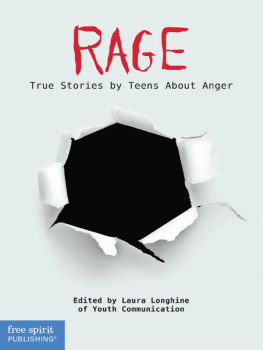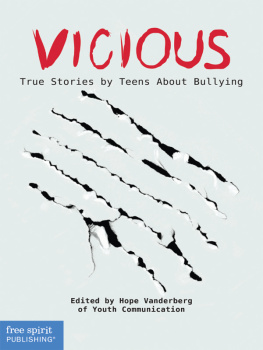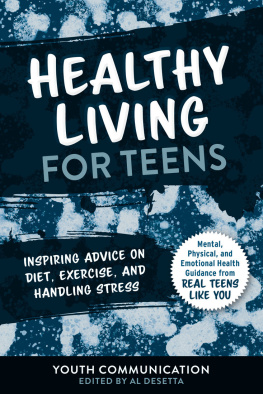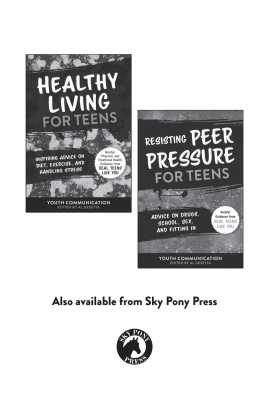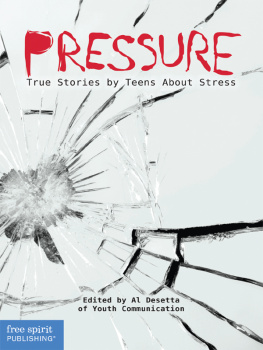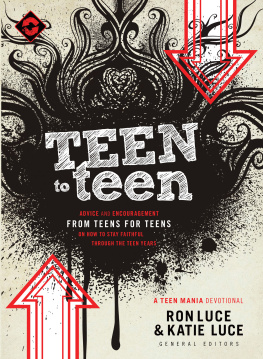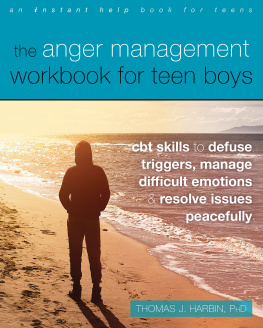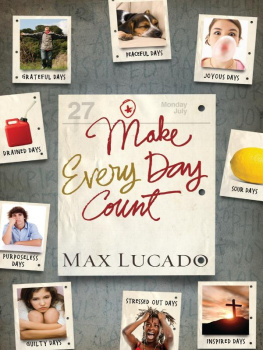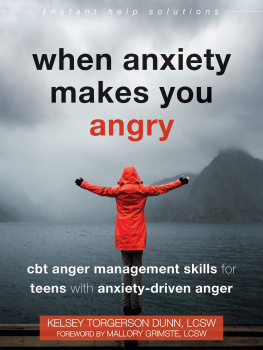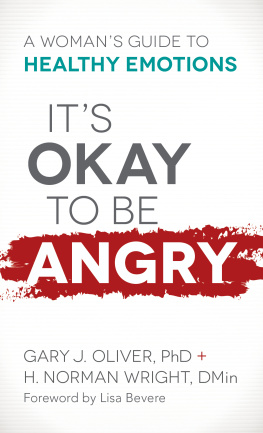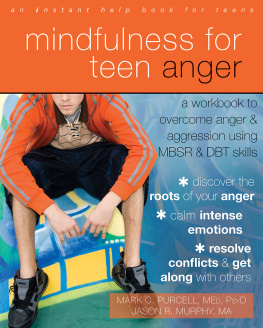
Copyright 2012 by Youth Communication
All rights reserved under International and Pan-American Copyright Conventions. Unless otherwise noted, no part of this book may be reproduced, stored in a retrieval system, or transmitted in any form or by any means, electronic, mechanical, photocopying, recording, or otherwise, without express written permission of the publisher, except for brief quotations or critical reviews. For more information, go to www.freespirit.com/company/permissions.cfm.
Free Spirit, Free Spirit Publishing, and associated logos are trademarks and/or registered trademarks of Free Spirit Publishing Inc. A complete listing of our logos and trademarks is available at www.freespirit.com.
Library of Congress Cataloging-in-Publication Data
Longhine, Laura.
Rage : true stories by teens about anger / edited by Laura Longhine.
p. cm. (Real teen voices series)
Includes index.
ISBN 978-1-57542-414-9 ISBN 1-57542-414-2 1. Anger in adolescenceJuvenile literature. I. Title.
BF724.3.A55.L66 2012
155.5'1247dc23
eBook ISBN: 978-1-57542-654-9
Free Spirit Publishing does not have control over or assume responsibility for author or third-party websites and their content. At the time of this books publication, all facts and figures cited within are the most current available. All telephone numbers, addresses, and website URLs are accurate and active as of May 2012. If you find an error or believe that a resource listed here is not as described, please contact Free Spirit Publishing. Parents, teachers, and other adults: We strongly urge you to monitor childrens use of the Internet.
Photo credits from Dreamstime.com: cover Ljupco, p. 5 Dnf-style, p. 15 Pcheruvi, p. 26 Geotrac, p. 34 Velkol, p. 45 Ronfromyork, p. 56 Epantha, p. 67 Vlue, p. 78 Nickp37, p. 87 Braendan, p. 96 Msymons, p. 103 Imagesolution, p. 110 Xaoc, p. 119 Marianmocanu, p. 127 Fotosmile, p. 135 Cwd, p. 140 Caravana, p. 151 Lostbear, p. 155 Edoma
Reading Level Grades 9 & up; Interest Level Ages 13 & up;
Fountas & Pinnell Guided Reading Level Z+
Cover and interior design by Tasha Kenyon
10 9 8 7 6 5 4 3 2 1
Printed in the United States of America
S18860612
Free Spirit Publishing Inc.
Minneapolis, MN
(612) 338-2068
www.freespirit.com
Free Spirit offers competitive pricing.
Contact for pricing information on multiple quantity purchases.
CONTENTS
Julie Stewart
Julie finds that opening up about her feelings helps her deal with them in more constructive ways
Fred W.
At a residential treatment center, Fred begins to understand how his past controls him and discovers how to get a better grip on his emotions
Robin Chan
Robin takes up karate as a positive way to release his anger
Natasha Santos
An abusive past has left Natasha with anger and panic attacks
Griffin K.
Griffin struggles to control an explosive temper during conflicts with troublemakers at school
Valencia B.
Once Valencia finds people who believe in her, she starts believing in herself
Onician Wood
Onician spends years struggling with his anger at his father, who left before he was born
Shateek Palmer
Shateek turns his rage into winning on the wrestling mat
Tiffany H.
The consistency, consequences, and caring that Tiffany received when she lived at an all-girl therapeutic treatment facility help her control her anger and handle her frustration
Shateek Palmer
Writing helps Shateek make sense of his losses
Tray T.
With the help of staff members at his group home, Tray finds less destructive ways to deal with his emotions
Otis Hampton
Otis channels his feelings of powerlessness and rage into a writing persona he calls the Crippled Enigma
Joseph Ballew
After years of living with abuse, Joe hopes hell move past his anger in a new home
Miguel Ayala
Physically abused by his mother, Miguel takes out his anger on others by being a bully and on himself by attempting suicide
Miguel Ayala
Miguel describes programs that have tried to help him manage his emotions, and explains what works and what doesnt
Anonymous
The author resolves to deal with the anger shes developed from her abusive childhood so she wont abuse others
Natasha Santos
A therapist explains to Natasha how anger from your past can affect your future
an interview with Toni Heineman, therapist
A therapist describes healthy and unhealthy ways to express anger
INTRODUCTION
The teen years can be tumultuousa time of flux and personal discovery. Classes get tougher, demands and expectations get higher, relationships with friends and family are changingeven bodies are changing. But some teens also deal with losing contact with family members, being bullied, growing up with abuse or neglect, or having to live with strangers who dont care for them. Some teens are in situations where they are not able to express their feelings, or they learn to express their feelings in destructive ways.
As a result, teens may have a hard time knowing what they feel. As many of the teen writers in this book explain, anger becomes the only emotion they have left. And though expressing their rage can feel empowering in the moment, uncontrollable anger usually leaves teens feeling powerless. It can lead to serious consequences and threaten their goals for the future.
In these essays, teens write about their struggles with anger and describe how their abusive pasts have affected their emotions. They are frank about the negative ways theyve let out their feelings, but also write about learning to express themselves in more positive ways.
Many of the writers talk about an anger that feels out of control, but which they desperately want to contain.
In The Monster Inside, Griffin K. writes about his struggle to stop himself from releasing his rage on the people around him: When I look back, I see that I was always waiting for someone to intervene, someone to stop methe teachers, my counselor, security, or the police. When I was hurting someone, I was looking around like a child, hoping someone would take control of the monster inside me.
The writers are honest about the fact that controlling their anger is often an ongoing struggle. But they also show that its possible to get help, both from other people and on their own.
The teens in this book have learned many strategies for keeping calm, including deep breathing, counting, knitting, drawing, cleaning, listening to music, dancing, playing sports, spending time with friends, reading self-help books, walking away from arguments, and trying to avoid upsetting situations. Most importantly, the teens find that learning to express their emotions, and not bottling up their pain, helps them control their anger.
Good therapists help several writers open up about their feelings. When Fred W. talks in an anger management group, he feels relieved. Letting out some of my emotions was the best thing Ive done, he writes. It helped me find out who I was. It felt great to break my familys taboo against talking about our feelings or discussing what happened inside our house.
A sympathetic new foster parent helps Julie Stewart start to express herself. By opening up her heart and home to me, she gave me a feeling of belonging, Julie says about her new foster mom. She talked with me about the emotions I had from all the abuse, and that in itself made me feel a little less angry.

